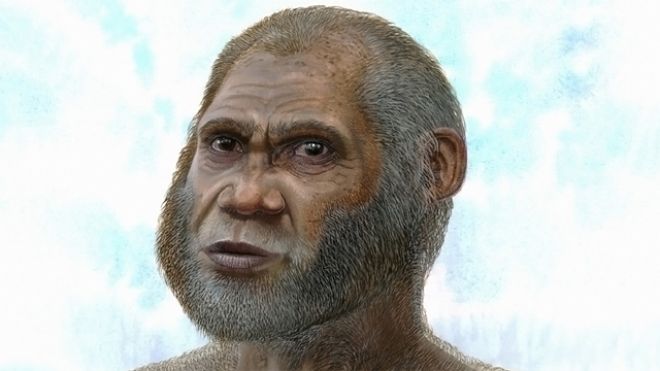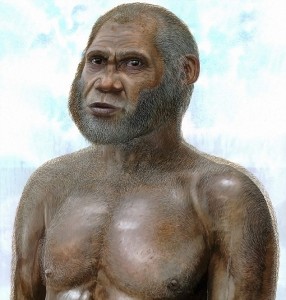Red Deer Cave People: Another New Hominid!
Posted by: Loren Coleman on March 14th, 2012
We were not alone. We are not alone. The world is revealing more of its fossil treasures – or at least humans looking through their storage areas of past finds are – and so here is some more breaking news of a find of a possibly new species of a relatively recent hominid.


A skull, possibly from a new species of human, recovered from Longlin cave in Guangxi province, China. Photograph: Darren Curnoe
The fossilised remains of stone age people recovered from two caves in south west China may belong to a new species of human that survived until around the dawn of agriculture.
The partial skulls and other bone fragments, which are from at least four individuals and are between 14,300 and 11,500 years old, have an extraordinary mix of primitive and modern anatomical features that stunned the researchers who found them.
Named the Red Deer Cave people, after their apparent penchant for home-cooked venison, they are the most recent human remains found anywhere in the world that do not closely resemble modern humans.
The individuals differ from modern humans in their jutting jaws, large molar teeth, prominent brows, thick skulls, flat faces and broad noses. Their brains were of average size by ice age standards.
“They could be a new evolutionary line or a previously unknown modern human population that arrived early from Africa and failed to contribute genetically to living east Asians,” said Darren Curnoe, who led the research team at the University of New South Wales in Australia.
“While finely balanced, I think the evidence is slightly weighted towards the Red Deer Cave people representing a new evolutionary line. First, their skulls are anatomically unique. They look very different to all modern humans, whether alive today or in Africa 150,000 years ago,” Curnoe told the Guardian.
“Second, the very fact they persisted until almost 11,000 years ago, when we know that very modern looking people lived at the same time immediately to the east and south, suggests they must have been isolated from them. We might infer from this isolation that they either didn’t interbreed or did so in a limited way.”
One partial skeleton, with much of the skull and teeth, and some rib and limb bones, was recovered from Longlin cave in Guangxi province. More than 30 bones, including at least three partial skulls, two lower jaws and some teeth, ribs and limb fragments, were unearthed at nearby Maludong, or Red Deer Cave, near the city of Mengzi in Yunnan province.
At Maludong, fossil hunters also found remnants of various mammals, all of them species still around today, except for giant red deer, the remains of which were found in abundance. “They clearly had a taste for venison, with evidence they cooked these large deer in the cave,” Curnoe said.
* * *
Much of Asia was also occupied by Neanderthals and another group of archaic humans called the Denisovans. Scientists learned of the Denisovans after recovering a fossilised little finger from the Denisova cave in the Altai mountains of southern Siberia in 2010.
The fossils from Longlin cave were found in 1979 by a geologist prospecting in the area. At the time, researchers removed only the lower jaw and a few fragments of rib and limb bones from the cave wall. The rest of the skeleton was left encased in a block of rock, which sat in the basement of the Yunnan Institute of Cultural Relics and Archaeology in Kunming, Yunnan, for 30 years. The fossils were rediscovered in 2009 by Ji Xueping, a researcher at the institute, who teamed up with Curnoe to examine the remains.
“It was clear from what we could see that the remains were very primitive and likely to be scientifically important. We had a skilled technician remove the bones from the rock, and they were glued back together. Only then was it clear what we had found: a partial skeleton with a very unusual anatomy,” Curnoe said.
The fossils at Maludong were found in 1989 but went unstudied until 2008.
Lumps of charcoal uncovered alongside the Longlin fossils were carbon dated to 11,500 years, a time when modern humans in southern China began to make pottery for food storage and to gather wild rice in some of the first steps towards full-scale farming.
See entire article by Ian Sample, by clicking here: The Guardian

If you wish to view a more technically evolutionary discussion of this find, please click on the Dienekes blog, here.
About Loren Coleman
Loren Coleman is one of the world’s leading cryptozoologists, some say “the” leading living cryptozoologist. Certainly, he is acknowledged as the current living American researcher and writer who has most popularized cryptozoology in the late 20th and early 21st centuries.
Starting his fieldwork and investigations in 1960, after traveling and trekking extensively in pursuit of cryptozoological mysteries, Coleman began writing to share his experiences in 1969. An honorary member of Ivan T. Sanderson’s Society for the Investigation of the Unexplained in the 1970s, Coleman has been bestowed with similar honorary memberships of the North Idaho College Cryptozoology Club in 1983, and in subsequent years, that of the British Columbia Scientific Cryptozoology Club, CryptoSafari International, and other international organizations. He was also a Life Member and Benefactor of the International Society of Cryptozoology (now-defunct).
Loren Coleman’s daily blog, as a member of the Cryptomundo Team, served as an ongoing avenue of communication for the ever-growing body of cryptozoo news from 2005 through 2013. He returned as an infrequent contributor beginning Halloween week of 2015.
Coleman is the founder in 2003, and current director of the International Cryptozoology Museum in Portland, Maine.










No way a skull like that translates into a Ben Bernancke look alike. Who are these guys kidding with that nonsense?
Another biped besides humans that likes to eat deer? Gee, who could that be?
These knuckleheads will only go kicking and screaming to the bitter end…
Yep, Terrible reconstruction drawing. Buzz-cut and an Amish beard.
Once again evolutionists prove they are as racist as their founders.
Given this description I don’t think the artists rendering is that far off. The beard hides the jutting chin and without any further information it would be foolish to guess at skin tone or amount of body hair. All they can go by is what we know so far.
What I found most interesting in the article is this quote:
This leaves the door open for a lot of changes in science. The Human family tree may become more inclusive. I would think the fact that the Red Deer Cave people cooked their meat is a good indication of being on ‘this side’ of that line. But there are so few traits that are specifically human. Social groups are well known through out the animal world. Tool making isn’t nearly as rare and special as we once thought. Even ants farm aphids so I’m not sure that farming can be a deciding factor either, and where do you draw the line between agriculture and simply learning to replant something you’ve come to enjoy the taste of? So far the use and ability to control fire seem to be one of the very few things that is still rather specific to the human race.
Okay, this has been bothering me all evening:
Can you explain what you mean by that? Because I am apparently missing something in the articles and/or artists rendering. I know medium to darker skin tones are used traditionally due to two reasons. 1] out of Africa model of human evolution, (especially now with the theory that Neanderthal mutated to lighter skin in order to absorb vitamin D in the colder, less sunny environments of Northern Europe. 2] our predecessors spent most of their time out in the weather hunting and gathering with little to no protective clothing, hence most would have more melanin to protect themselves from the sun’s radiation. As for any facial features, those are determined by the shape of the skull so that’s a non-starter.
So, please, explain to me how anything regarding this article is racist.
Next time a scientist asks you where the sasquatch/yeti fossil remains are, run this one and the Hobbit past him and ask him:
Um, where were these?
This is an amazing time to be in the field of paleoanthropology; first the Hobbits, then Denisovans, and now the Red Deer Cave people! Now we just need a giant hominid found to put the icing on the cake!